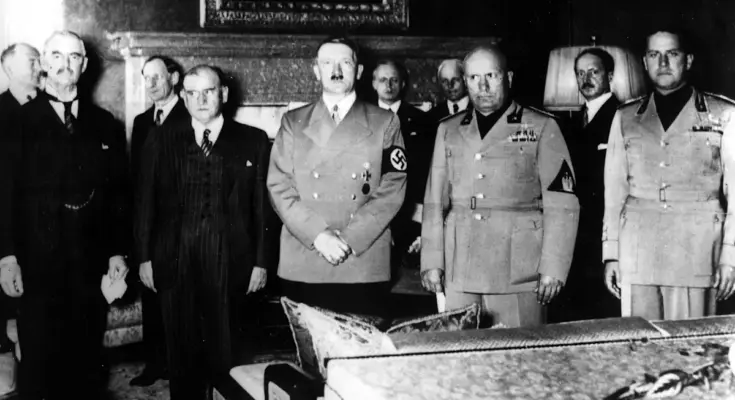Those who do not know the past are destined to repeat their mistakes. That is why a good knowledge of history has long been considered one of the most important prerequisites for successful diplomacy. Tempi passati! Not only in Germany, but also in America. Unfortunately, this is demonstrated by the 28-point “peace plan” negotiated by Donald Trump and Vladimir Putin for Ukraine.
Even the external circumstances resembled a low point in foreign policy: the Munich Agreement of September 30, 1938 concerning the Czechoslovak Republic. At the time, Germany under Hitler’s leadership was a highly aggressive dictatorship that aggressively questioned existing borders with threats. Intimidated by the dynamism and dishonesty of its partners, the only great power in Europe, England, wanted to defuse the situation at all costs.
The parallels with the current plan for Ukraine are clear: the United States, as a Western power, secretly negotiated the 28 points with confidants of the Russian rulers. The aggressor Putin, whose war of aggression has so far cost the lives of at least half a million people on both sides, soldiers and civilians alike, will be rewarded and his victims punished: If Ukrainian President Volodymyr Zelenskyj does not agree to the 28 points, his country will likely lose the support of the United States, its most important partner in the fight for survival so far.
In 1938, the victim was the former CSR, who was led by both negotiating partners to reach an agreement (weak French Prime Minister Daladier and Italian dictator Mussolini actually played no role). First, the treaty imposed the cession of large areas of Czechoslovakia. Second, these conditions destroy the country’s remaining defense capabilities. Third, the treaty contained weak promises from the Third Reich, for example about an “International Committee” to clarify disputes, which had no effect.
The 28 points of the current plan are very similar: Russia should not only be allowed to retain conquered territories through massive violence, but should also be granted additional territories that the Kremlin demands without any legal basis (point 21). Since the fortifications built there in the last years of the war had to be evacuated without a fight, Ukraine would be defenseless against further attacks, as the CSR did in 1938. The necessary reduction in the number of the Ukrainian army (point 6) was added – here the proposal even went beyond the Munich Agreement.
At the same time, the agreement contains two breach points at points 10 and 22, which almost suggest that Putin should continue his aggression: in the event of a breach, all security guarantees must be lost. The Russian secret services, the FSB and GRU, may soon prepare an operation modeled after the “Gleiwitz Radio Station Raid” on August 31, 1939, which was the “reason” for the German attack on Poland. SS commandos in Polish uniforms attack a German radio station.
However, Russia’s promises are no match for what is written on the paper. “It is hoped that Russia will not attack neighboring countries and that NATO will not expand further,” is point 3. And point 4 promises “dialogue” between Russia and NATO “with the aim of ensuring global security.”
A minimal knowledge of contemporary history is enough to remind us of the German-British declaration that Prime Minister Neville Chamberlain wrested from Hitler on the morning of September 30, 1938: “We are determined that the path of consultation should be the path to be adopted for resolving further questions affecting our two countries, and we resolve to continue our efforts to eliminate possible causes of discord and in this respect contribute to ensuring peace in Europe.”
Whether Chamberlain himself believed this or at least suspected that Hitler never wanted to comply is controversial among historians. But that didn’t matter: the Third Reich had violated every rule of international law if it was deemed to benefit the regime. So did Putin: Under his rule, Russia violated the principle of the inviolability of borders in Europe, established in the CSCE Founding Act in 1975 and reaffirmed several times since then, the Budapest Memorandum of 1994 and the two Minsk Agreements of 2014/15. It also opposes any further agreements that are valid under international law – and not merely fanciful, such as the expected commitment in 1990 not to expand NATO into the east.
Hitler never intended to abide by the rules of the Munich Agreement – just three weeks after signing, on October 21, 1938, he instructed the Wehrmacht through a “secret command matter” to prepare “the abolition of the entire Czech Republic.” It happened on March 15, 1939; Hitler himself created this event by playing with the Slovak CSR which was part of the government in Prague and thereby raising suspicions about the reason for the invasion.
Putin will look for any excuse for further aggression
It doesn’t take much imagination to imagine Putin’s next move after implementing Trump’s plan: conflict on the edge of the new borders imposed on Ukraine in the east and southeast could give him an excuse to revoke security guarantees. Or a real attack by disillusioned Ukrainian soldiers, which would most likely occur after the ceasefire; If, contrary to expectations, the Kremlin has experience with staged incidents a la Gleiwitz 1939 – remember the bombing of an apartment block in Moscow, among others, in September 1999, which became the pretext for the second Chechen war.
The main provisions in Ukraine’s plan have no precedent in the Munich Agreement and its accompanying agreements: Point 14 stipulates that America is entitled to half the profits from reconstruction projects in Ukraine. This is foreign policy in the age of the White House dealmaker: stability and reliability sacrificed without hesitation, even for the sake of vague promises of profit. This is a new quality even for Donald Trump.
The “peace plan” could be an accelerant to the coming war. At this point we can only guess whether Russian violence will first hit Moldova, Azerbaijan, the Baltic states, or Finland. What is fairly certain, however, is that the Ukraine plan – a new form of appeasement in the 21st century that is thought to have been overcome – is unlikely to last. Bad and ahistorical foreign policy achieves the opposite of its true goals.



